Octopuses are mollusks with eight limbs and a soft body. They, like all other animals, engage in mating for reproduction.
Male octopuses mate by using one of their arms to insert a sperm sac into the female. The sperm sac remains inside the female until she releases her eggs, fertilized outside her body.
Remember, the eggs are not fertilized inside the female. Instead, the female octopus fertilizes her eggs by carefully spreading the sperm over them after laying them.
I know you have more queries about the reproduction of octopuses. In this article, I will explain octopuses’ mating and spawning process in detail.
Reproductive Organs of Octopuses
Unlike most other animals, Octopuses are fascinating creatures with unique reproductive systems. Their reproductive system is an intricate network of specialized organs that enable them to reproduce and perpetuate their species.
Hectocotylus
Males of most octopus species possess a modified third right arm called the hectocotylus, which is exclusively used for mating and transferring sperm to the female. The hectocotylus is characterized by a long, slender structure with a sperm groove, which starts from the base and runs down toward the tip.
The tip of the hectocotylus is highly specialized, which helps in attaching to the female mantle cavity during mating. The hectocotylus ultimately ejaculates spermatophores anchored to the female’s mantle tissue, ensuring fertilization.
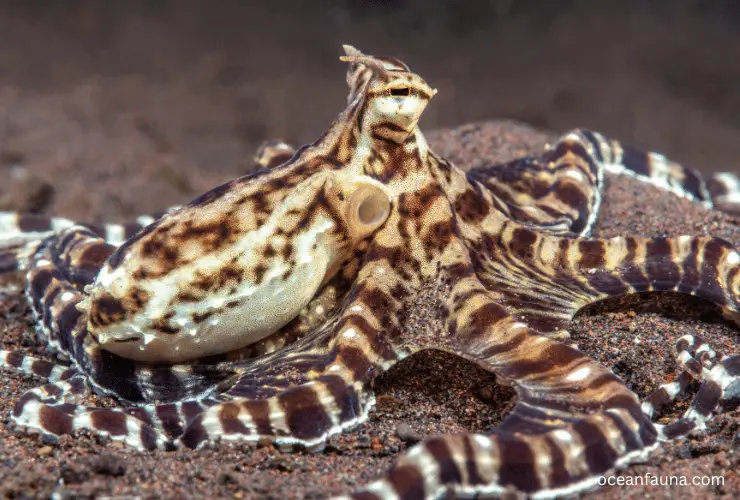
Ovary
The ovary of the female octopus is composed of small, fluid-filled sacs called ova. These ova are responsible for producing and storing eggs, which are released during the mating process.
The size and number of eggs produced by the ovary can vary, depending on the species and their environmental conditions. Females can produce thousands of eggs in a single breeding season.
Oviduct
The oviduct is a long, tubular structure transporting the released eggs from the ovary to the female’s arm tips. The oviduct is lined with cilia, which facilitates the movement of the eggs.
After reaching the arm tips, the eggs are brooded, and the female creates a string of eggs called the egg string. The egg string is an essential object, providing a safe and nutrition-rich environment for the developing eggs.
Spermatheca
The spermatheca is a specialized sac present in the female’s mantle cavity, where the male’s spermatophores are deposited. The spermatheca allows the female to store sperm packets until she is ready to fertilize her eggs actively.
The presence of spermatheca is an evolutionary adaptation that enables octopuses to delay fertilization until environmental conditions are favorable.
How Do Octopuses Mate?
As you know, male octopuses have a specialized arm on their third right side, called a hectocotylus, that is adapted for reproductive purposes. This arm features a sperm groove and a unique tip that helps with the mating process.
During mating, the male octopus approaches the female and extends his hectocotylus toward her. He will then use this arm to insert a sperm packet, called a spermatophore, into the female’s mantle cavity.
The sperm packet is then transferred to the female’s oviduct, where it remains until she releases her eggs.
Interestingly, fertilization does not occur inside the female’s body. Instead, the female carefully spreads the sperm on her eggs as she lays them, allowing them to be fertilized externally.
This unique strategy is advantageous for octopuses, as it ensures that each egg is fertilized correctly and enables them to produce many high-quality embryos.
Remember that octopuses are highly selective when it comes to mating partners. They use a variety of strategies to assess potential mates, including visual cues, smell, and touch. Males must be careful not to get too close to the female, as she may view them as a potential threat rather than a potential mate and will react accordingly.
What Is the Mating Season For Octopuses?
Octopuses have varying mating seasons, depending on certain environmental factors such as temperature, light, and nutrition. Typically, the mating season for octopuses occurs during the summer months, although this can differ depending on the location.
For instance, in Australia, female octopuses reach maturity during the spring and summer seasons and mate before laying their eggs.
In the Mediterranean, the common octopus reproduces from March to October, with a peak in the spring and early summer months. This is based on the research conducted by Mangold-Wirz in 1963 and Guerra in 1975.
It is worth noting that the common octopus does not have a specific mating season. Rather, it breeds continuously throughout the year, with a higher frequency during particular seasons.
Remember that octopus mating practices are complex and can vary depending on the species.
For example, the giant Pacific octopus has a more short-lived mating season, which typically occurs during the winter months, and it is a high-energy event that involves significant physical exertion.
When Can Octopus Reproduce?
Octopuses, like most creatures, reproduce once they reach adulthood. In the case of the Giant Pacific Octopus, anatomical studies have shown that they can mature and begin reproducing between 1.5 to 3 years of age.
However, these are just estimates, and the actual age of maturity can vary depending on a variety of factors, including the octopus’s gender, size, and environmental conditions.
Female octopuses typically reach sexual maturity before males and lay their eggs in protected areas before dying shortly after that. On the other hand, male octopuses will mate multiple times throughout their lifespan, and they have been known to mate with a variety of females.
Are Octopuses Oviparous?
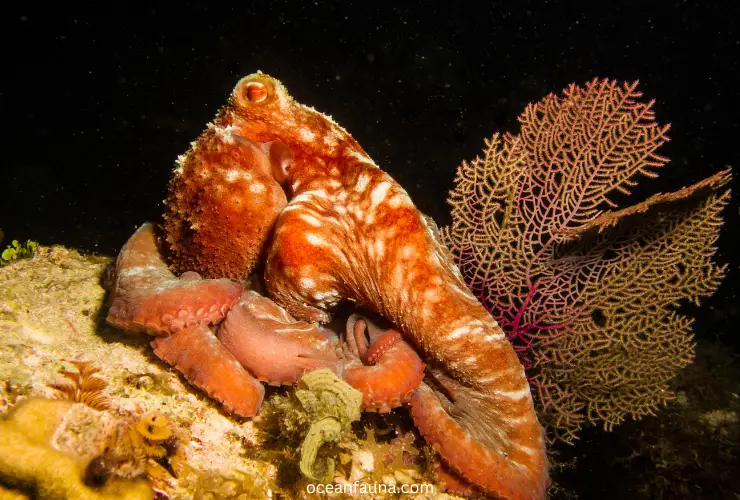
Octopuses are indeed oviparous, meaning they reproduce by laying eggs. However, their method of fertilization is unique compared to many other oviparous animals. Unlike other oviparous creatures that fertilize their eggs internally before laying them, octopuses fertilize them externally.
This external fertilization process is quite intricate and important for the survival of the octopus species. The female carefully spreads her male partner’s sperm on her eggs as she lays them, ensuring that each egg is fertilized correctly.
This process enables the octopuses to produce many high-quality embryos, ultimately increasing the chances of successful reproduction.
Octopuses can lay up to 200,000 eggs, providing them with a substantial advantage in the wild. If a significant number of these eggs hatch successfully, they have the potential to keep the population of octopuses thriving.
Additionally, this unique method of fertilization enables octopuses to avoid the energy expenditure and potential risks associated with carrying and giving birth to live young.
Where Do Female Octopuses Lay Eggs?
Female octopuses typically lay their eggs in a den that they excavate under rocks or within the crevices of coral reefs. This behavior is observed across a wide variety of octopus species and is primarily motivated by the need to protect their eggs from potential predators such as sharks, stingrays, and other octopuses.
The process of laying eggs is a critical and energy-intensive phase of an octopus’s lifecycle, and it requires significant preparation. Before laying eggs, female octopuses will typically excavate a suitable den that provides both protection and an adequate supply of oxygenated water.
They may also spend considerable time cleaning the den and lining its walls with small pebbles or bits of shell to create a safe and secure environment for their developing young.
Once the den is prepared, the female octopus will lay her eggs inside and remain near the den to guard and care for them until they hatch, typically around six months.
During this time, the mother octopus will use her siphon to circulate water through the den to ensure that the eggs receive an ample oxygen supply and remove waste products.
Do Octopuses Die After Giving Birth?
Yes, octopuses usually die after giving birth. Female octopuses are semelparous animals, reproducing only once and then dying. After a female octopus lays her eggs, she stops eating and weakens. By the time the eggs hatch, the mother octopus has passed away.
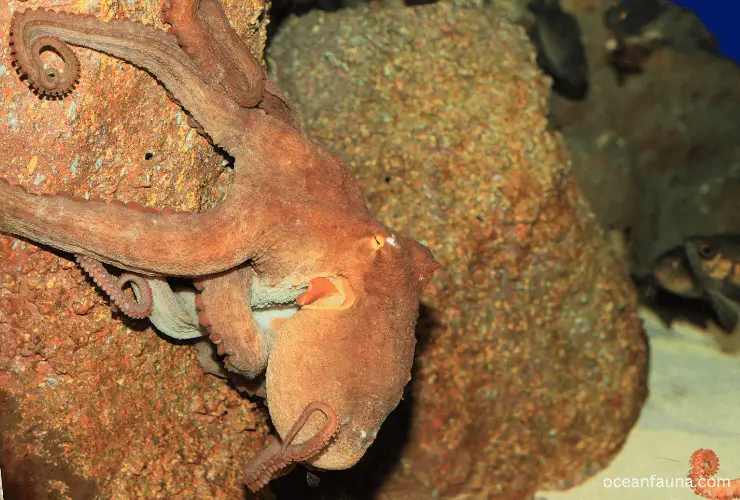
On the other hand, male octopuses usually die a few months after mating. This is because male octopuses exert a lot of energy and resources during mating, leaving them weak and vulnerable to predators.
However, certain species of octopuses are capable of storing sperm for several weeks after mating. This allows them to delay the fertilization process and time the hatching of their eggs with favorable environmental conditions.
In these cases, the female octopus would still die after the eggs hatch, but the male octopus would die before the fertilized eggs hatch.
Do Octopuses Reproduce Twice?
No, octopuses do not reproduce twice. In fact, they are known to mate only once in their entire lifetime. After mating, the male octopus passes away, and the female octopus lays her eggs and then soon passes away too.
This reproductive strategy, known as semelparity, is quite common among invertebrate animals. It enables them to make maximum effort during their single mating event in order to give rise to a large number of offspring.
It also has enabled octopuses to survive in diverse habitats despite facing significant threats from natural predators. By producing many eggs, octopuses increase the chances of successful reproduction and ensure the survival of their species.
How Long Does It Take for Octopus Eggs To Hatch?
Octopus eggs usually take about six months to hatch, although the duration could differ based on species, environmental conditions, and the number of eggs.
During this period, mothers will guard and care for their eggs until they hatch to ensure optimal conditions for the developing young. The mother may use her siphon to circulate water through the den, keep it oxygenated, and remove any waste products that might accumulate over time.
Once the eggs hatch, the baby octopuses must fend for themselves and immediately search for food. In most cases, they will disperse into open waters shortly after hatching and will never see their mother again.
How Many Eggs Does a Female Octopus Lay?
A female octopus can lay a very large number of eggs at one time – up to 200,000! However, despite the potential for a massive amount of offspring, only about 1/3 of the eggs typically survive to adulthood. This is due to a variety of factors, including predation, disease, and food availability.
Interestingly, after a female octopus lays her eggs, she undergoes significant physical transformation. She stops eating and becomes weaker and weaker over time. This is because the octopus spends almost all of her energy and resources caring for and protecting her eggs.
She will tirelessly clean and aerate the eggs and even blow water over them to keep them clean and properly oxygenated.
Unfortunately, the mother octopus does not survive to see her offspring grow up. By the time the eggs hatch, the mother has passed away due to the intense physical toll that caring for her eggs has taken on her body.
How Does a Baby Octopus Grow?
Octopuses are fascinating creatures that exhibit remarkable growth. Baby octopuses are born as larvae, which emerge from their parent octopuses’ eggs. These larvae are incredibly small, measuring only about the size of a pea. However, they possess all the essential features of mature octopuses.
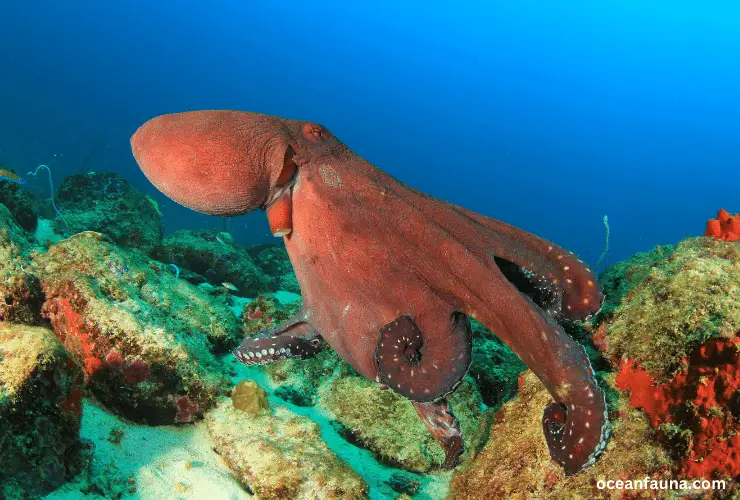
As these tiny creatures begin their lives, they embark on a journey of rapid growth. The growth rate of baby octopuses is quite astonishing; they double their weight every two to three months until they reach their full size.
The growth of baby octopuses depends on their nutritional intake and the optimal temperature of the water they live in.
Octopuses are voracious eaters, and baby octopuses are no exception. They have a massive appetite, which enables them to consume copious amounts of food. Food intake translates into rapid growth and development. Baby octopuses feed on small crustaceans, plankton, and other tiny marine organisms that they capture with their arms.
The optimal temperature of the water surrounding them is critical to the growth of baby octopuses. These creatures thrive in water temperatures ranging from 60°F to 75°F. Higher temperatures can cause stress and have a detrimental effect on their growth and development.
Like all octopuses, baby octopuses are cephalopods, which means they have highly developed nervous systems. This feature allows them to learn and adapt to their environment, which can positively impact their growth rate.
A lack of mental stimulation can negatively impact their growth, rendering them more susceptible to disease and stunted growth.
Conclusion
Hopefully, you have an in-depth idea of the reproduction strategy of octopuses. I explained the egg-laying and hatching process, as well as the growth rate and development of baby octopuses.
Moreover, I have discussed how parent octopuses die shortly after mating because of the intense physical toll of caring for them.
If you have any further queries regarding their mating and reproduction, keep your question in the comment section.

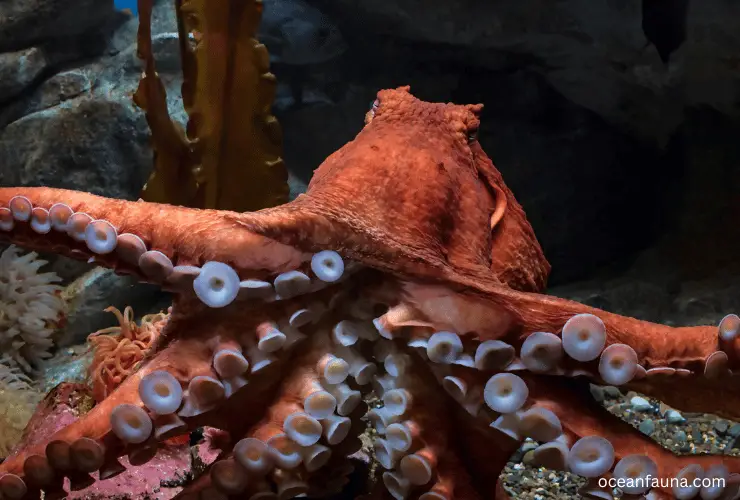
1 thought on “How Do Octopuses Mate? [Octopus Reproduction System]”